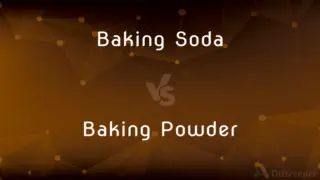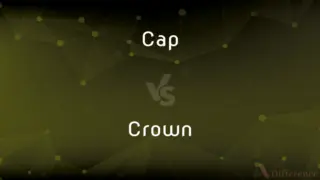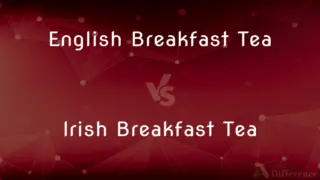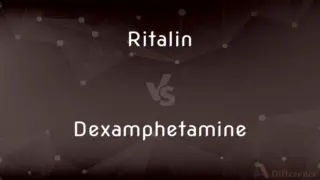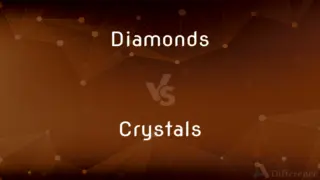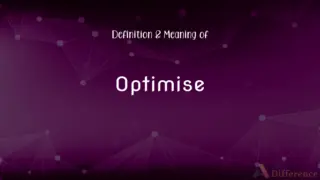Monosaccharide vs. Polysaccharide — What's the Difference?
Edited by Tayyaba Rehman — By Maham Liaqat — Updated on April 17, 2024
Monosaccharides are simple sugars with basic molecular structures, such as glucose, while polysaccharides are complex sugars like starch, composed of multiple monosaccharide units.

Difference Between Monosaccharide and Polysaccharide
Table of Contents
ADVERTISEMENT
Key Differences
Monosaccharides serve as the simplest form of sugar in the body, readily absorbed due to their single sugar unit structure. On the other hand, polysaccharides consist of long chains of monosaccharide units linked together, requiring enzymatic breakdown before absorption.
Monosaccharides are crucial for immediate energy supply, particularly in high-energy-demand situations. Whereas, polysaccharides act as storage forms of energy in plants and animals, gradually releasing glucose when needed.
The solubility of monosaccharides in water is generally high, making them quick to enter the bloodstream. In contrast, polysaccharides are less soluble and provide a slower, more sustained release of energy.
Monosaccharides such as glucose also play a direct role in metabolic pathways like glycolysis. Polysaccharides, however, are primarily involved in energy storage and structural functions, such as cellulose in plants and glycogen in animals.
Examples of monosaccharides include glucose, fructose, and galactose, each playing a unique role in nutrition and metabolism. Polysaccharides, such as starch and cellulose, differ in their roles, structural properties, and digestibility in the human diet.
ADVERTISEMENT
Comparison Chart
Complexity
Simple single sugar units
Complex, long chains of sugar units
Solubility
High solubility in water
Lower solubility compared to mono-
Energy Release
Immediate energy source
Slow, sustained energy release
Role in Metabolism
Direct involvement in glycolysis
Energy storage and structural roles
Examples
Glucose, fructose, galactose
Starch, glycogen, cellulose
Compare with Definitions
Monosaccharide
A monosaccharide important in energy production.
Glucose is often referred to as blood sugar.
Polysaccharide
A polysaccharide that plants use to store glucose.
Potatoes and rice are rich in starch.
Monosaccharide
A monosaccharide found in fruits and honey.
Fructose is sweeter than glucose.
Polysaccharide
A polysaccharide used in food as a gelling agent.
Pectin is used to thicken jams and jellies.
Monosaccharide
A monosaccharide component of RNA.
Ribose is crucial for RNA synthesis.
Polysaccharide
A polysaccharide stored in animal tissues.
Glycogen is stored in the liver and muscles.
Monosaccharide
A monosaccharide that combines with glucose to form lactose.
Galactose is less sweet than glucose.
Polysaccharide
A polysaccharide that is a major component of plant cell walls.
Cellulose is indigestible to humans.
Monosaccharide
A monosaccharide component of DNA.
Deoxyribose differs from ribose by lacking one oxygen atom.
Polysaccharide
A polysaccharide forming the exoskeleton of arthropods.
Chitin is found in the shells of crabs and lobsters.
Monosaccharide
Monosaccharides (from Greek monos: single, sacchar: sugar), also called simple sugars, are the simplest form of sugar and the most basic units (monomers) of carbohydrates. The general formula is CnH2nOn, or [Cn(H2O)n] or { CH2O}n albeit not all molecules fitting this formula (e.g.
Polysaccharide
Polysaccharides (), or polycarbohydrates, are the most abundant carbohydrate found in food. They are long chain polymeric carbohydrates composed of monosaccharide units bound together by glycosidic linkages.
Monosaccharide
Any of several carbohydrates, such as tetroses, pentoses, and hexoses, that cannot be broken down to simpler sugars by hydrolysis. Also called simple sugar.
Polysaccharide
A carbohydrate (e.g. starch, cellulose, or glycogen) whose molecules consist of a number of sugar molecules bonded together.
Monosaccharide
(carbohydrate) A simple sugar such as glucose, fructose or deoxyribose that has a single ring
Polysaccharide
Any of a class of carbohydrates, such as starch and cellulose, consisting of a number of monosaccharides joined by glycosidic bonds.
Monosaccharide
A simple sugar; any of a number of sugars (including the trioses, tetroses, pentoses, hexoses, etc.), not decomposable into simpler sugars by hydrolysis. Specif., as used by some, a hexose. The monosaccharides are all open-chain compounds containing hydroxyl groups and either an aldehyde group or a ketone group.
Polysaccharide
(carbohydrate) A polymer made of many saccharide units linked by glycosidic bonds.
Cellulose, starches, and complex carbohydrates, such as glycogen, are common polysaccharides in biology.
Monosaccharide
A sugar (like sucrose or fructose) that does not hydrolyse to give other sugars; the simplest group of carbohydrates
Polysaccharide
Any of a class of carbohydrates whose molecules contain chains of monosaccharide molecules
Common Curiosities
How are polysaccharides beneficial for long-term energy needs?
Polysaccharides store energy for later use, providing a steady supply.
What role do monosaccharides play in diseases?
High levels of certain monosaccharides, like glucose, can lead to diabetes.
What is the main dietary source of monosaccharides?
Fruits, honey, and sweet vegetables are primary sources of dietary monosaccharides.
What is the primary function of monosaccharides in the body?
Monosaccharides provide immediate energy to cells.
What makes cellulose unique among polysaccharides?
Cellulose provides structural support to plant cell walls, unlike other polysaccharides focused on energy storage.
How do plants and animals utilize polysaccharides differently?
Plants store glucose as starch, while animals store it as glycogen.
Is glycogen important for athletes?
Yes, glycogen stores are crucial for sustained energy during prolonged sports activities.
Can humans digest all types of polysaccharides?
Humans cannot digest cellulose but can digest starch and glycogen.
How does the body store excess monosaccharides?
Excess monosaccharides are converted into glycogen or fat and stored in the body.
Are all monosaccharides sweet-tasting?
Most monosaccharides are sweet, with fructose being the sweetest.
How does the body process monosaccharides compared to polysaccharides?
Monosaccharides are absorbed directly, whereas polysaccharides need to be broken down into monosaccharides first.
How do monosaccharides differ chemically from polysaccharides?
Monosaccharides consist of single sugar molecules, whereas polysaccharides are chains of multiple sugars.
What is the role of pectin in the food industry?
Pectin is used as a thickener and stabilizer in food products like jams.
Why are dietary fibers important although they are polysaccharides that cannot be digested?
Dietary fibers help regulate digestion and maintain bowel health.
Share Your Discovery

Previous Comparison
Mahayana vs. Hinayana
Next Comparison
Laptop vs. NetbookAuthor Spotlight
Written by
Maham LiaqatEdited by
Tayyaba RehmanTayyaba Rehman is a distinguished writer, currently serving as a primary contributor to askdifference.com. As a researcher in semantics and etymology, Tayyaba's passion for the complexity of languages and their distinctions has found a perfect home on the platform. Tayyaba delves into the intricacies of language, distinguishing between commonly confused words and phrases, thereby providing clarity for readers worldwide.




